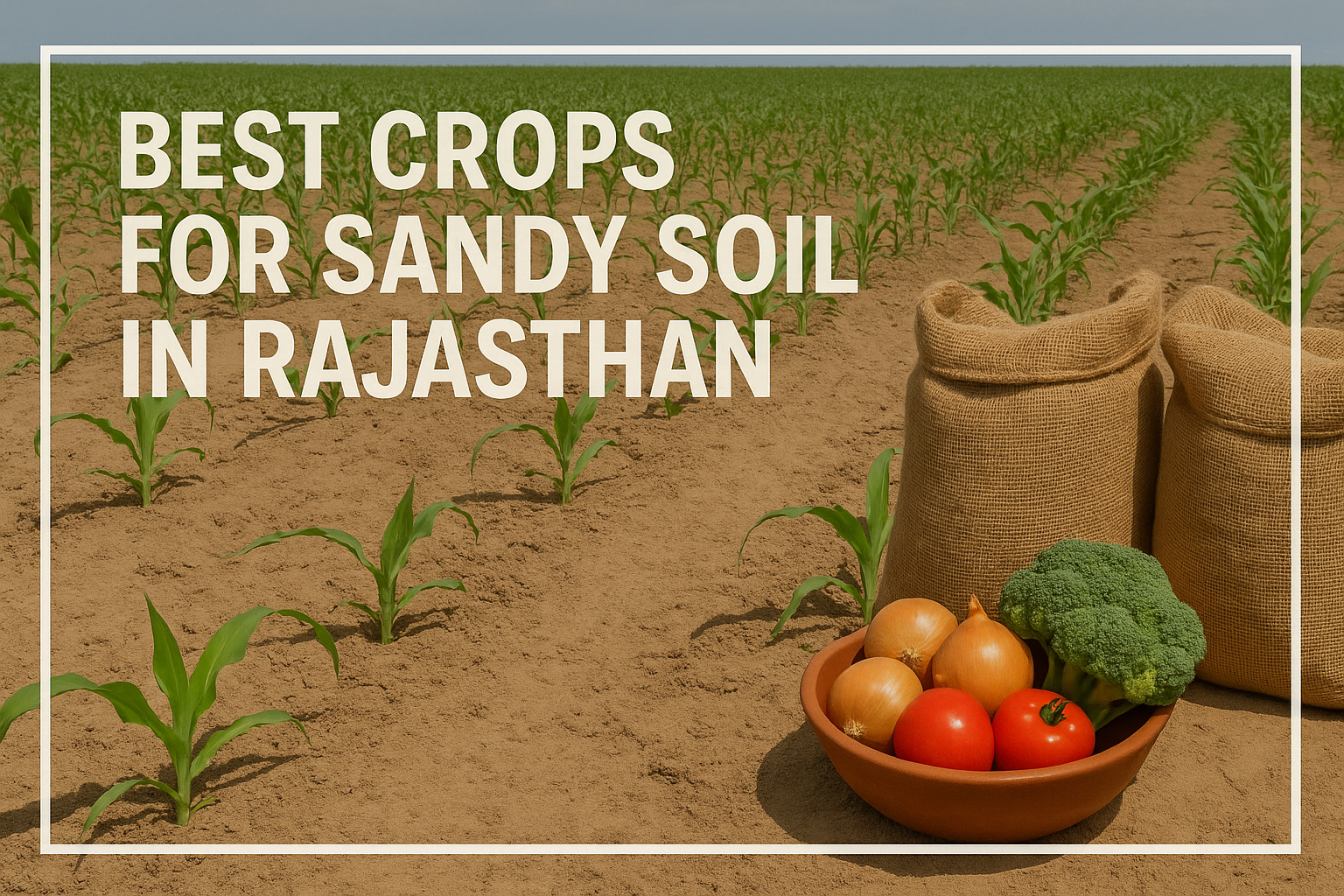
Best Crops for Sandy Soil in Rajasthan
Posted on November 20, 2025
Sandy soil in Rajasthan may seem tricky, but with the right crop choice, it can definitely be productive and profitable for Farmers. Rajasthan’s landscape is dominated by arid and semi-arid regions, and sandy soil is a common feature, especially in districts like Jaisalmer, Barmer, Bikaner, and parts of Nagaur. This type of soil is light, drains quickly, and warms up fast—but it also struggles to retain nutrients and moisture. So, choosing the right crops is not just smart; it’s essential. Sandy loamy soil is ideal for crops like millets, pulses, vegetables, and fruits. With proper management (adding organic matter and bio-mulching), it can support healthy plant growth even in dry climates.
Understanding Sandy Soil
Sandy soil is made up of large particles that don’t hold water well. It’s porous, which means water and nutrients can leach away quickly. Sandy soil is easy to work with, warms up early in the season, and allows roots to grow freely. With proper crop selection and management, it can be turned into a productive base for agriculture.
Best Crops for Sandy Soil in Rajasthan
Here are several crops that grow successfully in Rajasthan’s sandy region-
-
Pearl Millet (Bajra)
This is the king of sandy soil farming in Rajasthan. Bajra is drought-resistant, thrives in low fertility, and is a staple for both human consumption and fodder for animals. It’s commonly grown during the Kharif season (June-July) and suits the hot, dry climate perfectly.
-
Moong and Moth Beans
These pulses are ideal for sandy soil. They require minimal water, grow fast, and enrich the soil with nitrogen. Moong (green gram) and moth (matki) are popular choices among farmers in western Rajasthan.
-
Guar (Cluster Bean)
Guar is a hardy legume that not only survives but thrives in sandy soil. It’s used for food, fodder, and industrial gum production. Guar is a cash crop in Rajasthan and performs well even with limited irrigation.
-
Sesame (Til)
Sesame is another drought-tolerant crop that suits sandy soil. It’s grown for its oil-rich seeds and has a short growing season. Farmers prefer it for its low input requirements and decent market value.
-
Cumin (Jeera)
Cumin is a winter crop that does well in sandy loam. It needs dry weather during maturity and is sensitive to waterlogging—making sandy soil a good match. Rajasthan is one of the leading producers of cumin in India.
-
Isabgol (Psyllium)
This medicinal crop is gaining popularity in sandy regions. Isabgol requires well-drained soil and dry weather, making Rajasthan’s climate and soil ideal. It’s used in pharmaceuticals and Medicinal ways.
-
Watermelon and Muskmelon
These fruits grow well in sandy soil due to its warmth and drainage. With proper irrigation, especially drip systems, farmers in Rajasthan have successfully cultivated melons for local markets and export.
-
Tomatoes and Chillies
With some organic and soil mixture formation and regular watering, Soil Mulching can support vegetables like tomatoes and chillies. These crops are sensitive but rewarding if managed well. Follow all standards of practice. Farmers can cultivate such crops.
Tips for Successful Farming in Sandy Soil
Organic Matter is Key: Add compost, manure, or green cover crops to improve water retention and nutrient levels in soil.
Drip Irrigation: This method conserves water and delivers it directly to the roots, which helps to continue watering of field crops. Also helps to save water for the season.
Mulching: Helps retain moisture and reduce evaporation of water. There are bio-mulching, Covering of runner crop in between the main crop, which covers the open soil.
Crop Rotation: Rotating legumes with cereals improves soil health and reduces pest cycles. Changes the crop cycle to maintain soil health and nutrient availability.
Organic Farming Practices for Sandy Soil
To make sandy soil more fertile and resilient, organic methods are also essential. Here are sustainable ways to improve productivity in sandy soil naturally:
- Add Organic Matter- Use compost, farmyard manure, and green manure to improve water retention and nutrient levels. Vermicomposting and bio-slurry from biogas units are excellent additions.
- Mulching- Cover the soil with crop residues, dry leaves, or straw to reduce evaporation and suppress weeds.
- Bio fertilizers- Use Rhizobium, Azotobacter, and phosphate-solubilizing bacteria to enhance nutrients easily available in nature.
- Natural Pest Control- Neem oil, Dashparni, cow urine-based sprays, and trap crops help manage pests without chemicals.
- Water Conservation- Adopt drip irrigation and rainwater harvesting to make the most of limited water. Also, adopt the precision irrigation techniques.
Local Wisdom and Adaptation
Farmers in Rajasthan have adapted to sandy soil over generations. Traditional knowledge, combined with modern techniques like soil testing and precision irrigation, has helped improve yields. Many farmers now grow dual-purpose crops (those that serve both as food and fodder) to maximize land use.
Conclusion:
Sandy soil may not be the easiest to farm, but it’s far from useless. With the right crops and timely management, it can support a diverse and profitable agricultural system. Rajasthan’s farmers have shown that resilience and smart choices can turn even the harshest landscapes into productive fields.
